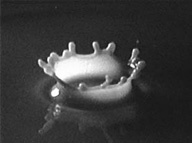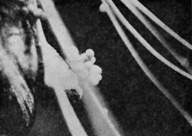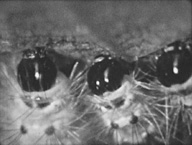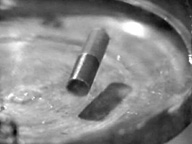D program Japanese Masterpiece Selection 1: Watch! Learn! Understand!
Seeing is understanding with this program, as in the saying, “A picture’s worth a thousand words.” Taking the history of the progress of Japanese science movies as a starting point, these are four works in which one can experience the delights of observation and experimentation.
 Science Graffiti
Science Graffiti
(“Science Graffiti: Kagaku to eizo no sekai”)- JAPAN / 1984 / Japanese / Color / 16mm (Original: 35mm) / 27 min
Director, Script: Horikoshi Kei
Photography: Seki Haruo
Music: Akasaka Toji Commentary: Takita Yusuke
Producers: Oguchi Teizo, Fujise Suehiko, Sakurai Tomoko
Planning: Fujifilm Corporation
From micrography to computer graphics, this film traces the path of how scientific research has developed in terms of image technology. Since its establishment in 1950, Iwanami Productions has led the field of Japanese scientific films, and produced Science Graffiti on the commemoration of the 50th anniversary of the founding of Fujifilm.
 The World of the Vacuum
The World of the Vacuum
(“Shinku no sekai”)- JAPAN / 1953 / Japanese / B&W / Video (Original: 16mm) / 11 min
Director, Script: Nakamura Rinko
Photography: Hiroki Masamiki
Producer: Ishimoto Tokichi
Production Company, Source: Nichiei Kagaku Eiga Co., Ltd.
Through various experiments, this film unlocks the truth about the air you can’t see inside a vacuum, and shows the vacuum technology used in the making of things such as vacuum tubes and chemicals. Nichiei Kagaku Eiga, after becoming independent from Nippon Eigasha, released this and other outstanding works, such as The Ecology of Tuberculosis (1952).
 The Balance of Nature
The Balance of Nature
(“Shizenkai no tsuriai: Dobutsu no kazu wa nani de kimaru ka”)- JAPAN / 1972 / Japanese / Color / 16mm / 25 min
Director, Planning: Nunomura Tatsuru
Script, Photography: Kawasaki Tatsuhiko
Production Company, Source: Toei Educational Media Dept.
Of a fall webworm’s 10,116 eggs, what percentage will make it to adulthood? Through careful tracking, the subtle equilibrium of the natural world is made clear. In 1954, Toei branched out into educational films. They made a number of social-education films, juvenile dramas, and the like, in addition to many others intended for use as educational material in schools.
 The World of Extreme Conditions
The World of Extreme Conditions
(“Kyokugen no sekai: Chokoatsu, choteon, chokyojiba”)- JAPAN / 1987 / Japanese / Color / 16mm / 31 min
Director, Script: Ogawa Hirotaka
Photography: Matsumoto Toshiyo
Music: Miyashita Shigeru
Narrator: Date Ken
Technical Advisors: Institute for Solid State Physics, the University of Tokyo
Producer: Tsuchiya Shogo
Planning: Tokyo Shoseki Co., Ltd.
Production Company, Source: Tokyo Bun-ei Films Co., Ltd.
A literally “experimental” film, which presents one after another worlds that are completely removed from the normal circumstances of human life: the world of extreme barometric pressure, the world of extreme cold at absolute zero, the world of super-strong magnetic fields in which polarity is reversed, and others. An introduction to the physics of condensed matter under extreme conditions, the academic discipline that seeks the ultimate rules that determine the properties of matter.
